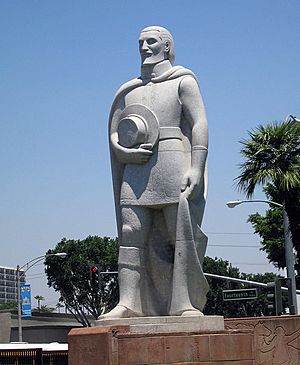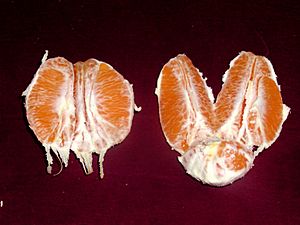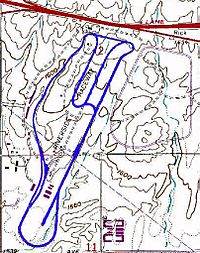History of Riverside, California facts for kids
Riverside, California, started as a town in 1870. It got its name because it's located right next to the Santa Ana River. Later, in 1893, it became the main city, or county seat, for Riverside County, California.
Contents
Early Days: Native American Life
Before Spain took over parts of Mexico and California, different Native American groups often visited the land where Riverside is now. We don't know of any lasting villages here, but explorers later wrote about small settlements near the river. Things like old tools found at White Sulphur Springs and grinding holes in rocks near Mount Rubidoux show that Native Americans were active in this area long ago.
Spanish Explorers Arrive
On March 20, 1774, a Spanish explorer named Juan Bautista De Anza arrived in the Riverside area. He was on a trip to find a good land route from southern Mexico to Alta California (which is now California). He and his group described the area as a beautiful "Valley of Paradise" (Valle de Paraiso). They said it smelled like rosemary and other herbs, and had rich grass for their horses and cattle. This was the first official record of the place that would become Riverside.
De Anza came through the area again on December 31, 1775. This time, he was leading a group of settlers heading for Monterey. They spent New Year's Eve by the Santa Ana River and crossed it the next day.
Today, a marker in the Martha McLean – Anza Narrows park shows where De Anza's group likely crossed the Santa Ana River. To remember his journeys, the city of Riverside built a 20-foot statue of De Anza. It was finished in 1942 and stands at Market and 14th streets.
American Settlement and Growth
In November 1869, a group called the California Silk Center Association was formed. They owned some of the land that would become Riverside. But this group broke up in April 1870 when their silk farming expert, Louis Prevost, died.
Then, on September 12, 1870, a new group called the Southern California Colony Association of Jurupa was created. Two days later, they bought much of the Silk Association's land and water rights. At first, the new settlement was called Jurupa, after the original ranch in the area. But on December 18, 1870, the Colony Association officially named it Riverside.
The Amazing Orange Story
In 1873, a woman named Eliza Tibbets changed California forever. She convinced William Saunders, who worked for the United States Department of Agriculture, to send her some new seedless oranges from Bahia, Brazil. Eliza planted and cared for these orange trees in Riverside.
These oranges, later called the Washington Navel Orange, were a huge success! They helped start the massive citrus industry in California. For over 60 years, this industry grew from those two small trees Eliza Tibbets planted.
Before Eliza's oranges, California had some citrus, but the quality wasn't always the same. Most oranges came from seeds. Eliza planted her two trees in 1873. People say she kept them alive by using dishwater because her home wasn't connected to the main water supply. The first fruits appeared in 1875–76.
When the Washington Navel Orange was shown publicly in 1879, everyone saw how special it was. It was high quality, had a great shape, size, color, and texture, and had no seeds! It also grew well in Riverside's dry climate, and its thick skin made it easy to ship. This new orange was so much better than others that most new orange groves planted these trees. Eliza Tibbets even sold parts of her trees to nurseries, which helped spread this amazing orange far and wide.
How Oranges Changed California
Eliza Tibbets' successful oranges led to a huge increase in citrus planting, especially the Washington Navel Orange. This growth in Riverside spread across California, boosting the state's economy. By 1917, the Washington Navel Orange business in California was worth $30 million a year. By 1933, it grew to $67 million annually. From one million boxes of oranges in 1887, California shipped over 65.5 million boxes of oranges, lemons, and grapefruit by 1944!
The success of Eliza's orange also led to many irrigation projects. These projects turned more desert land into orange groves. The huge and clever irrigation systems in Riverside were seen as wonders of their time. By 1893, Riverside was the richest city per person in the United States.
New cities and towns even popped up just because of the orange market. Places like Rialto, Fontana, Redlands, and Corona were created for citrus farming. The growing citrus industry also made land much more valuable. It helped Riverside survive when a big land boom ended in 1888.
Eliza Tibbets' orange also led to new businesses. It helped create fruit packing houses, inventions for boxing machines, fruit wraps, and even the first iced railroad cars. By the mid-1880s, Riverside had five packing houses. Many new farming methods were developed, like fumigation and orchard heaters. In 1897–1898, Benjamin and Harrison Wright invented a machine to wash oranges. Soon, most of Riverside's packing houses used these machines.
The Santa Fe Railroad opened a direct line to Riverside in 1886, making it easier to ship oranges east. Eight years later, the first refrigerated rail cars carried oranges from Riverside to the east.
Growers also worked together. In 1893, the California Fruit Growers Exchange was founded. This group, now known as Sunkist Growers, Incorporated, helped farmers market their crops.
Scientists also played a big role. They studied how to grow, handle, transport, and sell oranges better. In 1893, cyanide gas was used to fight citrus pests. In 1906, the University of California started its Citrus Experiment Station in Riverside. This station, which later became the University of California, Riverside, brought scientific help to the citrus industry.
Eliza Tibbets' orange helped California agriculture switch from wheat farming to fruit. Wheat had been the main crop from 1870 to 1900. But as the soil became tired from wheat, farmers started growing fruit. This change gave California's economy a strong base.
Asian-American Community History
Riverside has a rich history of Asian-American communities. Japanese and Korean immigrants settled near the railroad tracks, where thousands of workers would come during the citrus harvest. Many Chinese American and Korean American people live in the Arlington and La Sierra areas of Riverside today. The largest Korean American church in the city is Riverside Korean Baptist Church.
Riverside's first Chinatown was in Downtown Riverside. But because of growing anti-Chinese feelings and new city rules, the Chinese community moved to an area near Brockton and Tequesquite Avenues. The last person living in this Chinatown, George Wong, died in the 1970s, and the buildings were torn down. Later, during construction plans, archaeologists found artifacts from Chinatown. These items are now at the Riverside Metropolitan Museum. The Chinatown site is now a protected historical landmark. In 2008, the Save Our Chinatown Committee was formed to protect the site and share Riverside's Chinese American history.
In 1915, a Japanese immigrant named Jukichi Harada, who owned a restaurant, bought a home in Riverside for his American-born children. He wanted them to go to public school. But neighbors accused him of breaking the California Alien Land Law of 1913, which stopped people who couldn't become citizens from owning land. The case, The People of the State of California v. Jukichi Harada, went all the way to the state Supreme Court. The court decided that the Harada children could own the land. Today, the Harada House is owned by the Metropolitan Museum of Riverside and is a National Historic Landmark.
Dalip Singh Saund, the first politician born in Asia to be elected to the United States Congress, represented a district that included Riverside in 1956. There has also been a large community of Indian Americans, including Sikhs and Punjabis, in Riverside for almost a century.
Filipinos (see Filipino American) have also been in Riverside for over 100 years. Many were "Pensionados," Philippine citizens sent to the U.S. to learn about freedom and self-government after the U.S. took over the Philippines from 1898 until its independence in 1946.
African-American Community History
The area around Howard and 12th streets holds the last parts of what was once a busy African-American neighborhood. The old Wiley Grocery store now hosts activities for the "Black" Prince Hall Masons. Nearby is the Church of Our Lady of Guadalupe, a special pilgrimage site. The current church was built in the 1920s. You can also find the Bobby Bonds recreation center, named after the famous baseball player. More information about Riverside's African American community is on the Riversider.Org website.
Sports History in Riverside
Riverside was home to the Riverside International Raceway from 1957 to 1989. Many different types of races were held there, including Formula One, NASCAR, and Can-Am. The raceway closed in 1989 to make way for a shopping mall and housing.
Riverside has also had three minor league baseball teams. The Riverside Reds played in 1941. Later, the Riverside Red Wave played from 1988 to 1990, and the Riverside Pilots (a Seattle Mariners team) played from 1993 to 1995. These teams played at the UC-Riverside Sports Center. The Red Wave moved to Adelanto in 1990, and the Pilots moved to Lancaster in 1995. Today, a semi-pro college team, the Inland Empire Rockets, plays some home games in Riverside.
In the early 1940s, before World War II, the Riverside Rubes (also called Riverside Reds) played against the San Bernardino Bucs. This happened when two major league teams, the Cincinnati Reds and the Pittsburgh Pirates, held their spring training in the area. Later, in the 1950s, the Chicago White Sox and Philadelphia Phillies also trained here.
Riverside is the hometown of famous baseball players Bobby Bonds and his son Barry Bonds. Dusty Baker, a current manager for the Houston Astros, is also from Riverside. Even though they are from Pennsylvania, Ken Griffey and his son Ken Griffey Jr. have homes in Riverside.
Riverside's Timeline
Spanish Period
- 1774: On March 20–21, Juan Bautista de Anza travels through the Riverside area. He is looking for a land route to Alta California.
- 1775: On December 31, de Anza leads a second trip through Riverside. This time, he is bringing settlers to start a colony in northern California.
Mexican Period
- 1821: Mexico gains independence from Spain.
- 1838: Juan Bandini receives the Rancho Jurupa land grant.
- 1842: Benjamin D. Wilson, who later became the first mayor of Los Angeles, buys part of Rancho Jurupa. This land eventually becomes Rancho Rubidoux.
American Period
- 1848: On February 2, California becomes a U.S. territory after the Mexican–American War.
- 1850: California becomes the 31st state. The area that will become Riverside is part of Los Angeles County.
- 1853: San Bernardino County is formed, and it includes the Riverside area.
- 1869: John W. North meets Dr. James P. Greves.
- 1870: John W. North visits Riverside for the first time. The Southern California Colony Association is formed, and they buy land and water rights.
- 1873: Eliza Tibbets receives two special Navel Orange trees from the US Department of Agriculture.
- 1883: The city of Riverside is officially incorporated.
- 1893: On March 11, Riverside County is formed, and Riverside becomes its main city.
- 1903: The Glenwood Cottages hotel is renamed the Mission Inn.
- 1903: On May 7, President Theodore Roosevelt stays at the Mission Inn.
- 1909: President Taft visits the Mission Inn.
- 1961: The Mission Inn is named a California Historical Landmark.
- 1977: In October, the Mission Inn is named a National Historic Landmark.




